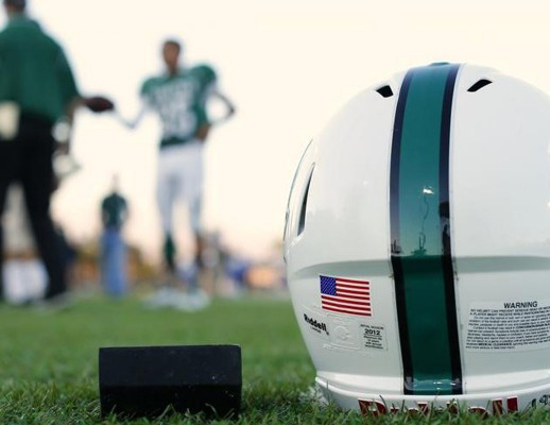Study: Practice without helmets
- Updated: January 8, 2016

For football players, practicing without helmets and shoulder pads may help reduce the number of head impacts in later practices and games, a new study suggests.
“The concept of practicing drills tackling and blocking without a helmet on is novel to the sport of American football,” said lead author Erik E. Swartz of the University of New Hampshire.

“I played rugby for a number of years and we don’t wear helmets, of course, in rugby,” Swartz told Reuters Health by phone. “So you don’t lead with your head.”
Football players who are used to doing everything with their helmets on may feel they are protected, and be more comfortable leading with their heads when tackling, he said. Taking away the helmets even briefly could take away that false sense of security.
The long-lasting dangers of concussions have become a hot-button topic both for professional athletes and for parents and coaches of school-age players.
Peter Landesman, director of football head trauma film “Concussion” that premiered on Christmas Day, told Reuters last week that American football may be in the early stages of “a seismic shift” as parents are dissuaded from letting their children play football amid safety concerns.
Swartz and his coauthors divided 50 NCAA Division 1 football players at the University of New Hampshire into two groups. Half did five-minute tackling drills without their helmets and shoulder pads as part of the Helmetless Tackling Training (HuTT) program twice a week during preseason practices and once a week during the three month season.
The other 25 players continued with noncontact drills and their usual routine, as reported in the Journal of Athletic Training.
Head impact sensors on the skin and helmets of the players showed that those who did the helmetless drills had 30 percent fewer head impacts per practice and game than the comparison group.
In the helmetless tackling group, head impacts per practice or game fell from almost 14 in the preseason period to 10 at the end of the season. At the end of the season, players in the comparison group were still having more than 14 head impacts per game or practice.
“To get it on the first try within the first study was very, very exciting and encouraging,” Swartz said.
Division 1 college football players are elite athletes. They seem to have made adjustments in their play with only one or two helmetless drills per week, but the same approach may not be as effective for other levels of play, he said.
“Eventually what we hope is to develop a program on any level of play, high school, college or pro, of a practice technique without the helmet,” in addition to doing drills with the equipment on, he said.
For now, it’s too soon for coaches to try to implement this system themselves.
“I wouldn’t want people to figure it out on their own, just because of the complexity,” Swartz said.
“We’re not ready to do any kind of widespread implementation,” he said.
With only 50 college players in these reported results, there were too few participants to look at actual injuries, but that’s something Swartz and his colleagues hope to do in the future with larger studies of high school and college players, he said.
Up to now, most head injury prevention strategies have focused on designing better helmets that minimize concussion risk, he said.
“I’m not saying that having a better helmet is something we shouldn’t do, but it’s only going to further contribute to this false sense of security,” Swartz said.
JOIN THE HSFB100 DISCUSSION: Create a user name | Post on The Varsity Board

You must be logged in to post a comment Login